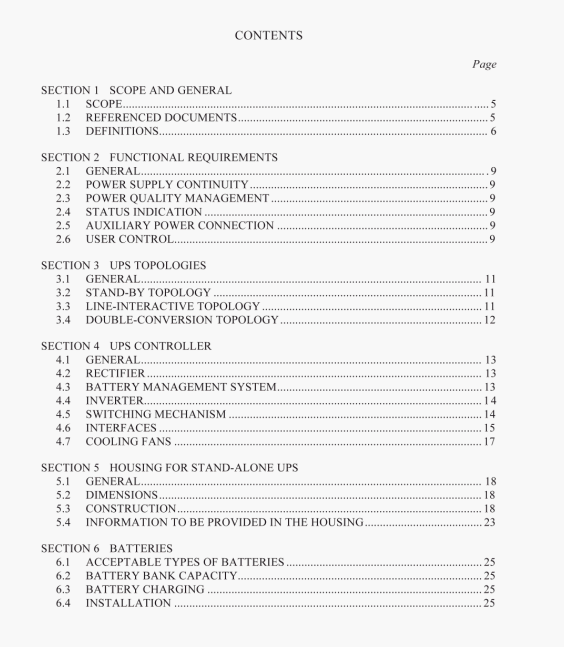AS 5715:2015 pdf – Uninterruptible power systems (UPS) for roadside devices.
4.1 GENERAL
The UPS controller consists of a number of functional elements:
(a) Rectifier.
(b) Battery management system.
(c) Inverter.
(d) Switching mechanism.
(e) Interfaces.
The UPS controller shall be adequately rated for the intended load specified.
NOTE: The intended load should be specified by the purchaser.
4.2 RECTIFIER
The rectifier of the UPS shall convert the input a.c. supply to a regulated d.c. output for use
by the UPS battery charger (see Clause 4.3) for charging the UPS storage batteries. For
UPS of the double-conversion type, this output shall also supply the UPS inverter
(see Clause 4.4).
4.3 BATTERY MANAGEMENT SYSTEM
4.3.1 General
The battery management system shall comprise a battery charger, sensors and control circuitry.
Under the full range of input supply voltages and environmental factors, and the full range of load conditions, including overloads, the battery management system shall do the following:
(a) Provide optimum charging and appropriately staged charge management of the type of storage batteries and capacities required for the UPS.
(h) Provide capacity to charge the storage batteries at their maximum rate of charge.
(c) Maintain the storage batteries in optimal state of charge for all conditions and circumstances of operation and prevent overvoltage being applied to the storage batteries.
(d) Recharge. including trickle charge when appropriate, the storage batteries under temperature compensation controlled conditions with feedback provided by a skin temperature sensor on a typical storage battery.
(e) Prevent the generation of undesirable harmonic currents in the supply authority’s circuits due to the charging operation.
(f) Limit ripple voltage on the d.c. rail of the storage batteries to less than 0.25% of the battery bus voltage.
(g) Prevent damage to the battery charger and ils power semiconductor components by providing automatic output current limiting for all forms of output current overload. The output current limiting function shall not cause the operation of supply protective devices for the power semiconductor components. Upon removal of the overload condition, the battery charger shall automatically return to normal operation.
(h) Provide appropriate indication within the UPS status indicators when an overload condition occurs to the battery charger.
(i) Provide a power factor of not less than 0.95 when the UPS is charging the storage batteries and the load is disconnected.
(j) Provide the required data to and accept commands from the user interface.
When the UPS is supplied by a portable generator with appropriate output ratings, the battery management system shall operate with the same performance as when the UPS is connected to normal mains power supplies.
4.3.2 Battery cell balancing
Where specified by the battery manufacturer, cell balancing shall be provided by the battery
management system.
4.4 INVFRTER
The inverter of the UPS shall do the following:
(a) Maintain the specified UPS output voltage to the specified tolerances over the full variation of the storage battery voltage.
(b) Shut down in the event that the output voltage cannot be maintained within the required parameters specified in Table 7.1.
(c) Shut down in the event that the inverter’s input d.c. voltage decreases below the minimum allowable.
AS 5715:2015 pdf – Uninterruptible power systems (UPS) for roadside devices
